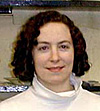
|
|
Meet the Faunal Expert
|
"Brooklyn's Eighteenth-Century Lott House"
1999-2001
|
|
|
 | Maura Smale, a Ph.D. candidate at New York University, is analyizing the animal bones from the Lott House as part of her dissertation. She is interested in the historical archaeology of the northeastern United States and the ways in which people's backgrounds influence their food choices. From the animal remains at the Lott House, she hopes to be able to tell what kinds of foods the family most frequently ate, whether they maintained the foodways of their native Holland, and where their food came from. She received her B.A. from the University of Chicago. A resident of Brooklyn for seven-and-a-half years, she considers the borough home. (Photo courtesy Brooklyn College) |
This 1999 season has seen a lot of shellfish. How can we date it? In fact, relative sizes can indicate whether some shells pre-date others. Because of pollution, the size of oysters decreased steadily until the 1870s, when oystering was outlawed in New York State. One piece of shell, not even a whole one, found in the midden here was bigger than Alyssa's hand.
![[image]](https://archive.archaeology.org/online/features/lott/thumbnails/lott49.gif) |
Oyster shells got smaller over time as pollution increased, but this one is bigger than Alyssa's hand. (Courtesy Brooklyn College) [LARGER IMAGE] |
But even though shellfish are very obvious now because they're sticking out of scarp (walls), they in no way made up the entirety of the Lott diet. Remember, you eat a lot of clams or oysters in a sitting. So each shell doesn't represent a meal. When I'm crunching numbers to determine what foods people ate in what proportions, I'll have to take that into account.
Mixed in with the shell and elsewhere across the property, we've found lots of bones of large domesticated mammals--cow, pig, sheep, goat. Many have been butchered (we can tell because of saw marks), indicating, of course, that they were eaten. I can tell by the thickness of the bones and other features the kind of animals the bones came from. Last season alone we had 2,200 bones--I just finished counting. By the way, oysters are used for other things than food. Shells are cut into buttons or ground for fertilizer. But the shells we're finding are intact.
Here's a rule of thumb for a making sense of bones: If you've got butchered limbs and ribs but no head or toes, you can guess these folks are buying or getting their meat elsewhere and consuming it on site. If you've got head and toes only, you can bet the animal was butchered on site and eaten elsewhere. On the Lott property we have a full spectrum of animal parts, so I think the Lotts raised some animals for milk and meat, sold some at market, and bought some at market.
I'd like to ultimately know from the faunal remains how Dutch the Lotts still were. My resources include a seventeenth-century Dutch cookbook, newly translated, which shows which foods were traditionally eaten. But traditional foods like coleslaw and doughnuts don't help me much--they don't leave a trace. The Dutch ate lots of stews, so back in the lab I will look for
low meat-bearing bones, like neck bones, which were often used in stews. Birds and fish were characteristically Dutch too, but their fragile bones, especially those of fish, don't always survive. We've found a good bit of pig, and I do believe the Dutch ate less beef than others. Last year we found a good bit of poultry. Another tool will be census records, which count the family's livestock.
Sometimes bones and rocks look very similar. What's the definitive test for recognizing bones? A broken end looks spongey. If that doesn't do it, I put it against my cheek. If it's cold, it's rock, if not, it's bone. As a last ditch effort, I put it on my tongue--if it sticks, it's bone. How do I date bone? Carbon dating will do it, but it's both expensive and destructive. So I date bones by the corresponding artifacts.
Lott House Main Page |
Field Notes |
Bulletin Board |
Faunal Analysis |
Oral Histories |
Recipes |
Primary Source Documents
|
Mystery Objects
|
Tools of the Trade
|
Stratigraphy lesson | Caretaker's Journal | Student Journals

© 1999 by the Archaeological Institute of America
archive.archaeology.org/online/features/lott/faunal.html |

